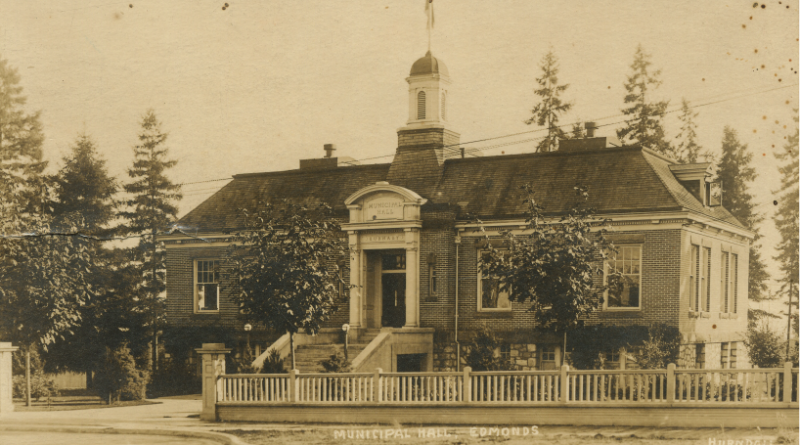
1911 (Sample Chapter)
A note to readers: This is a first draft of the 1911 chapter proposed for the book. It was completed March 20, 2006. By the time the book appears in 2009 it may be much altered.
The city grows . . . fast
The city got bigger on New Year’s Day. Hastings Townsite, the residents of which had voted the year before to be annexed by Vancouver, officially became part of the city on January 1st. The townsite was a big chunk of land. Superimposed on a map today, it would stretch from Burrard Inlet to East 29th Avenue between Nanaimo Street and Boundary Road. As well, a small chunk of CPR property called “No Man’s Land” was annexed by the city.
The city might have become even larger this year after South Vancouver ratepayers voted 1,914 to 200 in favor of annexation, but the provincial government refused to okay it, saying Vancouver was already over-burdened with administration problems. Not until 1929 would South Vancouver join us.
A second enlargement came with the opening of new buildings. They came thick and fast this year with the city’s astonishing growth, and many of these 1911 structures are with us yet. (And so is a company that built many of them: Dominion Construction, created this year by Charles Bentall.)
The most well-known of the 1911 buildings was an imposing new courthouse on West Georgia, replacing a much smaller building that stood just south of today’s Victory Square. The architect was F.M. Rattenbury, who was famous for having designed the legislative buildings and the Empress Hotel in Victoria. Today that courthouse is the Vancouver Art Gallery.
New church
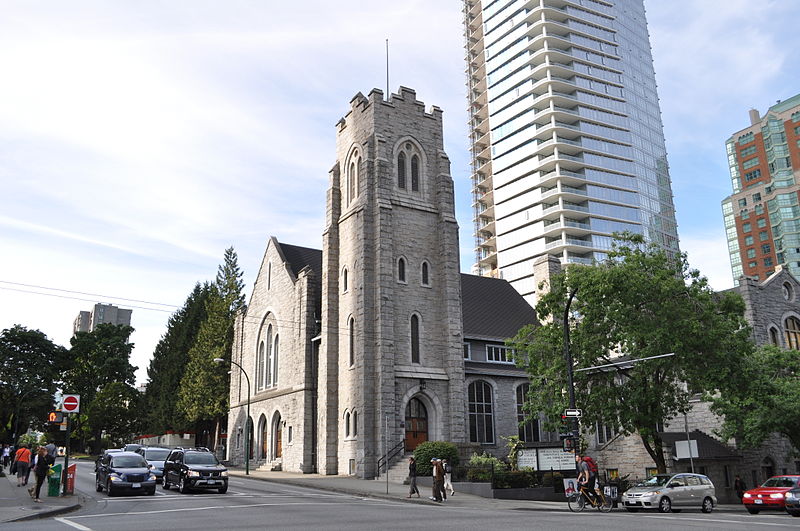
Image: Wikimedia
On June 9 the handsome First Baptist Church was dedicated. Situated at the northwest corner of Burrard and Nelson, the church replaced a smaller 1887 building that stood at Hamilton and Dunsmuir. An interesting fact about the new church is that when funds for its construction were first sought in 1904 the first person to step forward was John Morton, a Baptist lay person and one of the “Three Greenhorns,” the earliest Vancouver settlers. He donated $1,000, a full quarter of the money needed. Morton also laid the cornerstone for the church in 1910.
On September 11 the Vancouver Rowing Club opened in the building it occupies to this day. The Club had been formed in 1886 and opened its first clubhouse the following year. They had a rival in the Burrard Inlet Rowing Club, but in 1899 the two amalgamated. Not far away is the Stanley Park Dining Pavilion, also built in 1911, and home today to the Dubrulle Culinary Institute.
More to come
Many more well-known local structures got their starts in 1911, would be open for business the following year. They include the World Building (known today as the Old Sun Tower), Chalmers Presbyterian Church at West 12th and Hemlock (now the Anglican Holy Trinity Church), the current Point Atkinson Lighthouse, Brock House, B’nai Yehudah Synagogue, the Sylvia Hotel, the Rogers Building and the second Cambie Street Bridge.
Hockey Night in Vancouver
On December 20 Lester and Frank Patrick opened the world’s largest artificial ice rink on West Georgia at the corner of Denman. Known as the Denman Arena, it would be home to hockey (and, in the basement, the Vancouver Curling Club). Some 10,500 people could be packed into the Arena, and often were. The Patricks, helped by money from the family’s lumber business, also formed the Pacific Coast Hockey Association this year. Lester and Frank had been hockey stars in Ontario, and they promptly began raiding the eastern-based National Hockey Association for good players. The league began with three teams, all of which they owned: the Vancouver Millionaires, the New Westminster Royals (who also played in the Denman Arena) and the Victoria Aristocrats.
The Patrick brothers would create a lot of today’s hockey’s rules and features, including unrestricted passing in the central zone, the penalty shot, the play-off series . . . they put numbers on players’ sweaters and allowed their skaters to kick the puck. The PCHA credited players with assists and introduced the blue line to reduce offsides and speed up the game. They even changed the rule that said a goalie must stand at all times. See 1915 to learn how the Millionaires snagged Vancouver’s only Stanley Cup, helped by a dynamo named Fred ‘Cyclone’ Taylor.
The PCHA would fold in 1924.
More building
The Holden Building at 10 East Hastings went up this year, a fine 10-storey brick structure named for a prominent city realtor, William Holden. His extensive realty dealings led the newspapers of the day to write that “he made Granville Street.” It was Holden who bought the terminal lands on False Creek for the Great Northern Railway. (In 1929 the Holden Building would become our city hall for seven years, and in 1988 would be converted to residential use. Its name today: the Tellier Tower.)
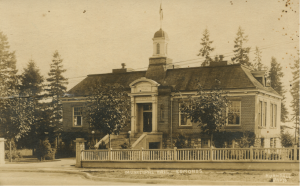
[Photo: Burnaby Community Archives]
If you’d like to see what sorts of houses were being built this year you can satisfy that curiosity by looking on the east side of Macdonald Street, south for a block or so from West 5th Avenue. There’s a long row of them there. Michael Kluckner, in his invaluable Vanishing Vancouver (1990), tells us that these Craftsman-style houses were all built by Lockie and Miller in 1911. “William Lockie was a carpenter,” Kluckner writes, “his partner, Miller, was probably also a carpenter . . . The men had no office other than their current jobsite, and they must have employed a large crew, as witnessed by the number of houses they built in a short time.”
Another indication of the explosive growth of the city this year: the CPR added 12 more stalls to the original 10 in its roundhouse in Yaletown. And construction started on the Connaught Bridge.
Burnaby built a new municipal hall this year. So did North Vancouver District. On a smaller scale on the north shore, next to the Capilano Suspension Bridge, William Farrell built a tea house (now the Capilano Trading Post) using cedar timbers stacked one on top of the other. So much timber, it was said, that eight tea houses could have been built. And still on the north shore, the Lonsdale Theatre opened; today it’s a bank.
Long Live the King!
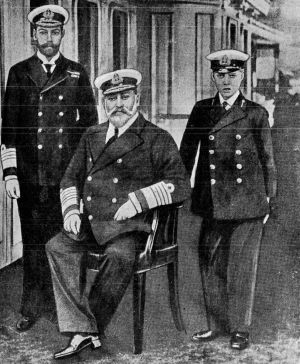
Image: gutenberg.org
On June 22, 1911 with the death of Edward VII, George V became King.
On October 13 Prince Arthur, the Duke of Connaught, became Canada’s Governor General, succeeding Earl Grey. The duke would leave his name on the Vancouver map when he visited us in 1912.
Schools
Farther west on the north shore the first elementary school opened in what in 1912 would become West Vancouver in, says one source, the Presbyterian tent. There were 14 pupils. (Speaking of West Vancouver, a real estate boom there this year saw waterfront lots advertised for as much as $4,500.) We have 1911 as the date for the opening of a one-room school in the White Rock area of Surrey. In Vancouver Henry Hudson school, named for the explorer, opened at Cornwall and Cypress, and Walter Moberly Elementary opened, named for the explorer-engineer who surveyed the Canadian Pacific Railway’s path through the Rockies.
In South Vancouver, not yet part of the city, Collingwood Heights School—which had started life in 1896 as Vancouver East School—was renamed for Sir Guy Carleton. (South Vancouver had held a contest in 1910 to rename its schools, and the students at Cedar Cottage School won, suggesting the names of famous Canadians. Carleton, born in Ireland, was the soldier who commanded the British troops in Canada during the American Revolution and repelled General Benedict Arnold’s attack.)
Education of another kind took root in Steveston this year. It had its origins in a little town in southern Japan called Mio-mura. A man named Gihei Kuno from that village came to Steveston in 1887 and was excited by the potential of the local fishing industry. Mio-mura was a fishing village, but it was going through hard times, losing much of its fishing grounds to Osaka. Kuno went back to his village and persuaded many young men to join him on his return to become fishermen here. By 1911 there were 649 Japanese from Mio-mura in Steveston (473 men, 176 women). There were enough kids to start a Japanese school, and one was established by the Japanese Fishermen’s Benevolent Society in Steveston. It had instruction in Japanese and a Japanese curriculum. More than 4,000 descendants of those original Mio-mura people live in Canada today, a full 10 per cent of all Japanese-Canadians. (By the way, the money sent back to the village by the small Japanese contingent here pulled Mio-mura out of its doldrums.)
The provincial government set aside 175 acres of land in Point Grey this year under the University Endowment Act for the projected University of British Columbia. But it would be another fourteen years before classes started there, and the amount of land granted would be greatly increased.
Transportation
Aviation was exciting people all over the world. The Wright brothers’ flight had occurred less than eight years earlier. On April 28 William Templeton, who would later (1931) become the first manager of the Vancouver Airport, built and flew a home-made tractor biplane—the propellor was in front—at Minoru Park race-track. This was the first plane built and flown in Greater Vancouver. (Can you imagine what it would have been like to look up and, for the first time in your life, see an airplane buzzing by far overhead? It must have been thrilling!)
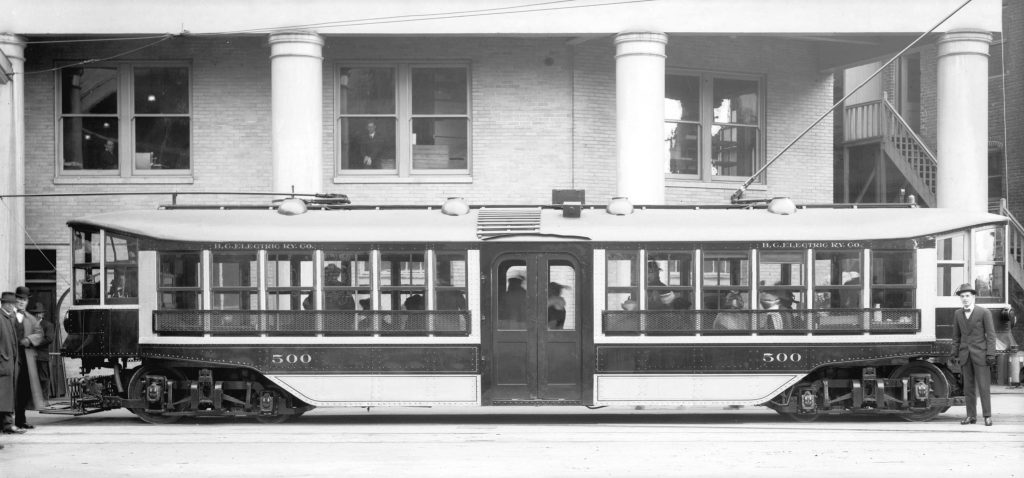
Image: City of Vancouver Archives
Down on the ground, the CPR announced plans to pull its marshalling yards out of Vancouver and create a major complex at Westminster Junction—now Port Coquitlam. The major reason for the move was that the railway’s 25-year tax holiday in Vancouver was about to end. More than 600 acres of land cutting diagonally through Coquitlam would be needed to hold 180 miles of track, roundhouses, “coal docks,” repair shops, etc.
It was, by the way, New Westminster’s grumpiness at being bypassed by the CPR in 1887 that led to the creation of Port Coquitlam. New Westminsterites insisted a spur line be built to run south to connect with them; it was at the point where that spur line left the main line that a tiny settlement began. Informally called Westminster Junction at first, in 1913 it would secede from Coquitlam and become Port Coquitlam.
The big news this year for the other national railway of the time, the Canadian Northern, was the knighting of its president Donald Mann. Alas, that honor didn’t help the railway. Port Mann, named for Sir Donald, was originally intended to be the road’s Pacific terminus, but the railway would run into financial difficulty and go bankrupt. It would become part of the Canadian National Railway in 1923.
On June 12 the Burnaby Lake interurban line was activated by the B.C. Electric Railway. It had a vitalizing effect on Burnaby’s growth that continued until the province-wide economic collapse of 1913. The line roughly correlated with today’s Highway #1, ended in Sapperton on Columbia just north of where Royal Columbian Hospital is today. The last run was October 23, 1953. (But the New Westminster terminal building is still standing, renovated for a Salvation Army thrift store.)
Teddy Lyons
One of Vancouver’s most cherished characters was streetcar “spieler” Teddy Lyons. He began his famous career this year aboard BC Electric car #124. This was an open-air streetcar, and Teddy would describe the town to visitors. He pointed out interesting sights as the car rattled along, told corny jokes and passed along local history. At one point during the journey Teddy would point up at a certain building, the passengers would all look up, a photographer inside the building would snap a photo . . . which magically became available at the end of the trip. There are literally thousands of these photographs extant today.
Teddy would conduct his tours for 39 years! Someone calculated he had travelled half-a-million miles through the city during his extraordinarily long tour-guide career. (A sample Teddy Lyons joke: “See that seagull flying up there? That’s the richest bird in Vancouver. This morning he made a deposit on a brand-new Cadillac.”)
At street level one of the city’s most famous thoroughfares was created. It had been the old North Arm Trail, then it became River Road. Its name was changed this year to Marine Drive, when Point Grey municipal council straightened and blacktopped it. The road was planned as a scenic loop around the Point Grey peninsula. It still is.
Transportation was the obvious theme of the city’s first Automobile, Motor Boat and Accessory Exhibition, which opened February 24.
Out on the water, on February 27 North Vancouver Ferry No. 3 was launched from Wallace Shipyards, the first self-propelled boat of any size to be built in North Vancouver. In June the Sea Foam—described as “slow but sturdy”—was added to John Lawson’s West Vancouver Transportation Company’s ferry fleet with a capacity of 40 or 60 passengers (we’ve seen both figures). Sometimes the Sea Foam towed freight barges hauling West Vancouver residents’ furniture and effects. Lawson’s other craft was the 34-passenger West Vancouver No.1 which, writes Phil Collings, “had started life as a Columbia River fish boat called the Eileen.” The ferries left from the foot of 17th Street and across the inlet to the foot of Columbia in Vancouver.
A company called Harbour Navigation began operating small ferry boats on the Fraser River this year. The company is still around under the name Harbour Cruises Ltd.
Business News
Construction news became a lot easier to get starting in 1911 with the appearance of the Journal of Commerce. Still extant, this is Vancouver’s oldest magazine. It provides an unparalleled record of construction in this area over the past century.
In February a fellow named George Torrance Cunningham opened a drug store in the city’s West End. Cunningham was born, writes Constance Brissenden, “on an oxcart trail in North Dakota in 1889. His family arrived in New Westminster in 1891. In 1904 he was hired as an apprentice druggist at Woodward’s, later worked at William M. Harrison’s ‘classy’ drug store/post office. He graduated from the Ontario College of Pharmacy in 1909, studied in New York and Chicago. At age 21, in February 1911, he opened his ‘No. 1′ Cunningham Drug Store at Denman and Nelson. He bought the Vancouver Drug Store chain in September, 1939, building his own chain from 12 to 35 stores. He would eventually command a 52-store empire.” In 1970, five years after Cunningham’s death, the chain would be sold to Shoppers Drug Mart.
Another long-lived Vancouver company, Broadway Printers, began this year. It was founded by German-born Friedrich Richard Blockberger and incorporated as the Canada Post Publishing Company November 11. It would change its name soon after. A company history says that during the early years of the firm “Friedrich would leave the company in the capable hands of his five sons as he headed off into the wilds of British Columbia looking for gold, returning only for the winter months when he would publish and print many mining related newspapers.”
Ladner Borden Gervais, one of Vancouver’s major law firms, had its origins this year when Leon Johnson Ladner began the practice of law. Born in Ladner, a community named after his father and his uncle, Leon Ladner went to school there and in New Westminster. After completing the Bachelor of Arts and the Bachelor of Laws degrees at the University of Toronto, he was admitted to the Bar in 1910.
The major employer on the north shore, Wallace Shipyards, at the foot of Lonsdale Street, suffered a tremendous blow July 11 when it was destroyed by fire. It rebuilt quickly, however, under its vigorous founder, Alfred (Andy) Wallace, and would continue for more than 80 years.
Banks expand
Two of the country’s major banks opened second branches in the city this year, an indication that eastern Canada was taking notice of the city’s remarkable growth. (The two institutions, the Bank of Toronto and the Dominion Bank, would merge in February, 1955.)
All this growth demanded more electrical power, and it came this year from a 52.5 megawatt powerhouse located at the outlet of Stave Lake, north of Mission City. The Mission Museum tells us: “By the end of 1911 a contract was secured to supply power [from the Western Power Co.] to Vancouver, New Westminister, Burnaby, Coquitlam, Maple Ridge, Mission and Bellingham, Washington. Power sales in 1911-12 were brisk. Smaller customers were supplied with their own transformers on site, while the bigger customers had to maintain an electrician and manage the electrical power supply at its delivery point.” Western Power would eventually be taken over by BC Electric.
New PM, new wards
On October 10 the Conservative Party, led by Nova Scotia-born Robert Borden, won the federal election, defeating Sir Wilfrid Laurier’s Liberals. Borden would be the country’s 12th prime minister. One of the successful local candidates was H.H. “Harry” Stevens, who had been elected to city council just a year earlier, and who now became the Member of Parliament for Vancouver City. Stevens would prove to be very influential in later years.
On the local political scene, the city increased the number of wards to eight. With two per ward, there were now 16 aldermen. The mayor was Louis D. Taylor, he of the famous red tie, serving his second one-year term. (See Biz Biz for 1926 on this site for a funny story about Taylor and his tie.)
The city’s first suffrage convention was held at O’Brien Hall this year, with Mayor Taylor as chairman. We can be positive that one of the prominent women at that meeting would have been Vancouver News-Advertiser reporter Lily Laverock, a crusader for votes for women.
Another woman who would later become prominent in local politics was London-born Helena Gutteridge. She arrived in Vancouver this year, aged 32, found work as a tailor, but—finding the local suffrage movement here “too polite”—would later (1913) go on to organize the B.C. Women’s Suffrage League, and beginning in 1917 fight for and win passage of B.C.’s first minimum wage act. (It varied by industry, but $13 to $15 a week was the range.) In 1937 she would become Vancouver’s first woman alderman.
Sports and Recreation
The opening of the Denman Arena was just the most spectacular sports event of the year. There was lots going on elsewhere. The first nine holes of the Vancouver Golf Club (situated, curiously, in Coquitlam) were opened for play. The club house was the old Austin farm house, with a dormitory for golfers who missed the last tram back to Vancouver or New Westminster.
The North Vancouver Tennis Club held its opening tournament on its courts at 23rd and Lonsdale, the site of the present Recreation Centre.
As for recreation, the Province reported on July 27 that one third of Vancouver’s population had passed through the gates of Stanley Park during the week of July 10-16, making it “one of the most popular pleasure resorts the Terminal City possesses.”
During the week mentioned “a census of every person entering the park was taken. A count was also taken of every auto, saddle horse, bicycle, dog, hack, and in fact every rig or conveyance . . . Sunday, the final day of the count, was of course the heaviest day of the week. On that day 21,738 pedestrians, 191 autos, 52 hacks, 367 rigs, 58 saddle horses, 148 bicycles and 173 dogs passed through the gates.”
A company called the Grouse Mountain Scenic Incline Railway was formed. It was created to build a 2.5-kilometre-long rail line that would carry its passengers up the mountain to a lavish ski resort hotel. But the scheme would collapse as the First World War loomed and steel became impossible to obtain.
Arts and Entertainment
On May 8 Fred Karno’s entertainment troupe from England began a week-long engagement at the Orpheum Theatre (not the present one) at Pender and Howe Streets. Among the performers, a 22-year-old not-yet-famous Charlie Chaplin. Our thanks to site visitor Robert Ingves for this item. A website (sadly no longer available) set up by A.J. Marriot listed every appearance made by Chaplin here: May 8, 1911; October 9, 1911; April 8, 1912; December 30, 1912, and September 8, 1913. Also appearing on the Karno bill that May 8, 1911 and on the last two dates cited: Stan Laurel, later to be half of the immortal team Laurel and Hardy.
Sculptor Charles Marega began teaching art for night school students. In December, Marega’s bust of David Oppenheimer, Vancouver’s second mayor, was installed in Stanley Park.
Pauline Johnson
One of the classic Vancouver books first appeared this year when Pauline Johnson published Legends of Vancouver. This little gem has been selling ever since. The story behind it is interesting. In 1910, BC Bookworld tells us, “Johnson had started publishing prose pieces in the Saturday Province Magazine, edited by Lionel Maskovski. These were privately printed as a fundraising initiative on her behalf by the Pauline Johnson Trust Fund. This project proved to be a runaway bestseller, released in official and pirated editions, even after it was formally published in 1911 as Legends of Vancouver.”
Perhaps the most famous story in the collection is the legend of Siwash Rock, which explains its origin: a young father-to-be was swimming in the entrance to the Narrows, while his wife was in the forest nearby about to give birth. “As he swam joyously to and fro, a canoe bearing Four Men headed up the Narrows. These men were giants in stature, and the stroke of their paddles made huge eddies that boiled like the seething tides.
“‘Out from our course!’ they cried as his lithe, copper-coloured body arose and fell with his splendid stroke. He laughed at them, giants though they were, and answered that he could not cease his swimming at their demand.”
Impressed with his courage and his devotion to tradition (swimming was a ritual for both parents of a new-born) the Four Men—the Sagalie Tyee—transformed the young man into a pillar of stone. His wife and their baby son, for he had now been born, were likewise transformed into two smaller pillars nearby.
A 1961 edition of the book, published by McClelland and Stewart, begins with a brief biographical sketch by Marcus Van Steen in which he says that Johnson wanted the book to be called Legends of the Capilano. “But,” says Van Steen, “she was too ill to insist, which is just as well as the present title is more accurately descriptive. Instead, she inserted a 100-word foreword telling of her debt to Chief Joe Capilano, his role in the Legends, and mentioning that most of them were being told in English for the first time.” Johnson was seriously ill with breast cancer, and would die in Vancouver in 1913, just short of her 52nd birthday.
Crime
On September 15 North America’s biggest bank-vault robbery to date happened right in little old New Westminster. Five men—or was it three? accounts differ—bound and gagged a janitor at the city’s sole Bank of Montreal branch and got away with more than a quarter of a million dollars. (Multiply that by about a hundred to gauge the impact today.) The men “probably escaped down the Fraser River by a launch or else by automobile towards Vancouver, but of how they got away there is no direct evidence.”
The Province cartoonist had a field day with the heist. One of his drawings showed two cops interviewing an elderly neighbour. “Have you seen any suspicious persons?” they ask. “Yes,” she says, “there was two reporters here this morning.”
In Burnaby, the fight against crime included hiring two mounted policemen this year and setting aside $250 for the purchase of two horses.
And Bill Miner, the “Grey Fox,” who had pulled off Canada’s first train robbery near Silverdale in the Fraser Valley in 1904, was captured in Georgia February 24 and sent to the state pen. He would die there two years later, having spent most of his adult life in prison.
Fragments
Vancouver’s population reached 120,847 in 1911, double what it had been five years earlier. And a study this year found that 34 per cent of Vancouver’s population was British.
The first full “peal” of the bells of Holy Rosary Cathedral was rung July 1st. They are the only English-hung (that is, free-swinging) church bells in the city. There are eight bells, called into use for ceremonial occasions including weddings, funerals and ordinations. This first full peal commemorated the coronation of King George V—although they could also have celebrated Canada’s 44th birthday. A full peal, in which the bells ring through more than 5,000 changes without a break, takes three hours.
On March 4 the Robert Kerr ran into grief and foundered. It will be converted to a coal hulk. This was the ship that served as a refuge in June, 1887 for people fleeing the Great Fire.
The Vancouver Fire Department was deemed by an international committee to be “one of the world’s finest . . . as regards equipment and efficiency” behind only London, England, and Leipzig, Germany. The city had 11 firehalls and 191 fire fighters.
The name of Park Drive in East End Vancouver—so named because it ended at the time at Clark Park—was changed September 25 to Commercial Drive. The name was changed at the urging of real estate promoters who wanted to bring into prominence what they predicted would be a great commercial thoroughfare.
The western stretch of Dundas Street in Vancouver was renamed Powell Street, to honor Dr. Israel Wood Powell who, among other good works, donated the site of Vancouver’s first city hall.
Vancouver’s first Italian newspaper, L’Italia nel Canada, appeared.
The Chinese revolutionary Dr. Sun Yat-Sen made his third visit to Vancouver.
Japanese settlers began growing strawberries in Surrey. The nearby community hall came to be called “Strawberry Hill.” The berries were sent to canneries in New Westminster and Vancouver.
Wisconsin-born Julius Harold Bloedel began logging in BC.
The first Vancouver Girl Guide Troop was started by Miss P. James.
Colony Farm at Essondale Hospital was considered the best in the West, yielding 700 tons of crops and 20,000 gallons of milk this year. The farm provided therapy as well as food for its patients.
A resolution was passed by Surrey Council to close the Serpentine and Nicomekl Rivers to navigation in order to construct dams for land reclamation. The era of steam boats and log booms on these rivers came to an end.
Samuel Brighouse, one of the “Three Greenhorns,” left Vancouver for England, where he died in 1913.
Nine-year-old Nat Bailey arrived in Vancouver with his family from Seattle. Years later he would launch what became the White Spot restaurant chain.
Many more well-known local structures got their starts in 1911, would be open for business the following year. They include the World Building (known today as the Old Sun Tower), Chalmers Presbyterian Church at West 12th and Hemlock (now the Anglican Holy Trinity Church), the current Point Atkinson Lighthouse, Brock House, B’nai Yehudah Synagogue, the Sylvia Hotel, the Rogers Building and the second Cambie Street Bridge. (By the way, the Sylvia wasn’t built as a hotel, but as an apartment block. It would make the switch in 1936.)
The opening of the Denman Arena was just the most spectacular sports event of the year. There was lots going on elsewhere. The first nine holes of the Vancouver Golf Club (situated, curiously, in Coquitlam) were opened for play. The club house was the old Austin farm house, with a dormitory for golfers who missed the last tram back to Vancouver or New Westminster. (A tidbit for buffs of local golfing history: one of the stops planned for the Burnaby Lake interurban line was ‘Golf Club’! It was near today’s Lougheed Mall. Alas, it was not to be.)
Image, top: Burnaby Municipal Hall, 1911 [Photo: Burnaby Community Archives]
